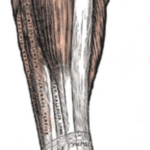If you’re a person who keeps in shape by power walking, running or playing sports you probably know what shin splints are. For those of you who don’t know what they are, it’s the tightness that you feel in your shins that can be very painful when you are in the process of doing some type of high energy activity. You get these shin splints or (medial tibial stress syndrome) from the constant pressure and intensive movement you put on lower leg muscles, bones, and tissue. This constant pressure starts causing the surrounding tissue to get inflamed or swell in turn causing the pain that ultimately could bring you workout to a stop.
Shin splints are not a huge problem, it’s not something you would commonly consult a doctor about but it is an issue you will want to address if you are still planning on working out. I personally love working out and found many different ways to deal with the problem. My favorite way of dealing with splints is walking or running through them until they go away, this is not the most comfortable way but it gets the job done. However, this is not a great way of dealing with them because you’re not actually getting rid of the problem you’re just masking it, kind of like taking care of a hangover by drinking again the next day.
Here are some more sophisticated ways of dealing with the problem.
Shoes: This should always be one of the first things you check, and try checking them before you start getting shin splints. Once your shins start to hurt you have already done damage, catching it early is the best way. Make sure your shoes fit tightly but comfortably, also make sure you have the right amount of cushion in your shoe to absorb the constant impact of each step. When shopping at any sporting goods store you will find someone that will help you. You can explain to them exactly what activities you are involved in and they will show you what types of shoes that will work the best for you. Ordering shoes on-line for exercising is not recommended, making sure they fit well for what you plan on doing with them before you buy them is a definite plus.
Switch Your Exercise: There are plenty of ways to do cardio without the impact of power walking and running. Swimming is a great way to target a lot of muscles and get cardio in at the same time. Bike riding and using other type of cardio equipment like an elliptical can all still help your cardio without the impact that causes shin splints. If you can rotate different exercises in throughout the week you might be able to avoid the situation all together.
Exercise other muscles in your legs: You’re only as strong as your weakest link. Working out other muscles in your legs like your calves and quads can help give you overall stronger legs which can help take some pressures off of your shins. You can also try jumping rope and or just jumping in place without landing on the heels of your feet. Jumping from the front of your feet only about an inch or two in the air repeatedly will help loosen your shin.
Ice the problem: Now not everyone will have to ice there shins but if you are an athlete it may be something you have to do. For most average people the pain will subside shortly after you are done working out. But for those who have no choice and are needed to go out on the field or on the court etc. whether you have pain or not, then icing your shins could be quite a lucrative practice.
Stretching: This is an important thing that is often over looked when working out or doing any type of high energy activity. Stretching before and afterwards can help you loosen up before you get ready for your activities and help your shins from getting tight after you activities. Simple stretches can go a long way; you can try standing on your toes and reaching straight up in the air until you feel a little burn in your shins and then holding that position for 30 seconds. You can also try kneeling down and sitting your but on your calves until you feel a little tension in your shines and hold that for about 30 seconds. Both are simple but effective ways of stretching out your shins for a better performance.
Shin splints can be annoying and can impede your workout goals. Treating your shins the right way will be the difference between a comfortable workout, a painful workout or a skip of your workout all together, and nobody wants that. So stretch well, wear good foot wear, ice your shins when needed and try to work out some of those other leg muscles and you should be able to overcome those pesky shin splints.
Note: If they won’t go away or they get worse especially if you’re not working out then you should start thinking about seeing a doctor.



